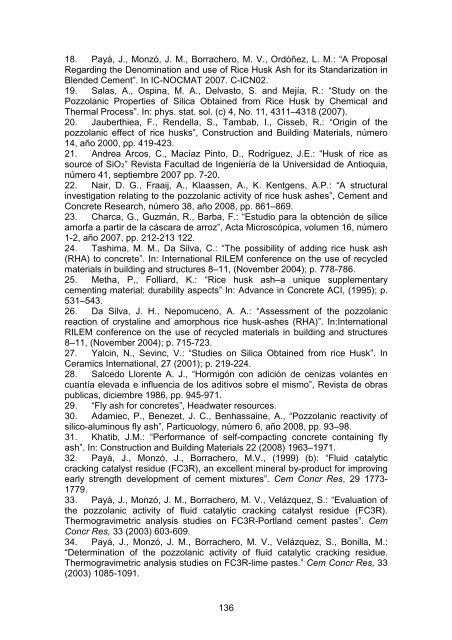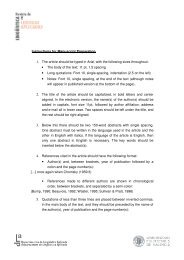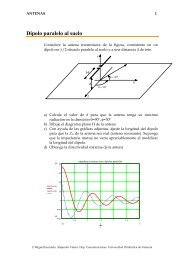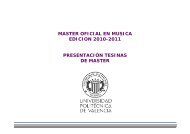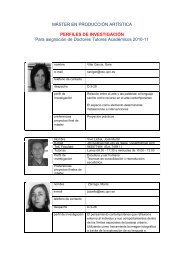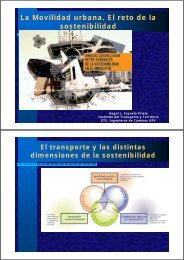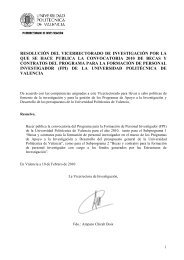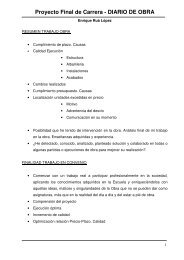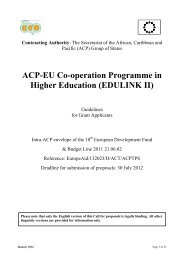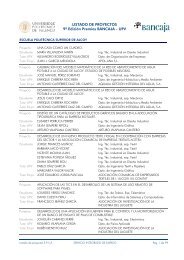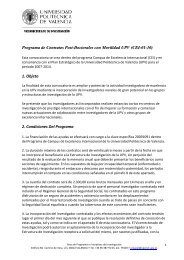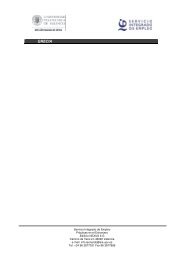18. Payá, J., Monzó, J. M., Borrachero, M. V., Ordóñez, L. M.: “A ProposalRegarding the Denomination and use of Rice Husk Ash for its Standarization inBlen<strong>de</strong>d Cement”. In IC-NOCMAT 2007. C-ICN02.19. Salas, A., Ospina, M. A., Delvasto, S. and Mejía, R.: “Study on thePozzolanic Properties of Silica Obtained from Rice Husk by Chemical andThermal Process”. In: phys. stat. sol. (c) 4, No. 11, 4311–4318 (2007).20. Jauberthiea, F., Ren<strong>de</strong>lla, S., Tambab, I., Cisseb, R.: “Origin of thepozzolanic effect of rice husks”, Construction and Building Materials, número14, año 2000, pp. 419-423.21. Andrea Arcos, C., Macíaz Pinto, D., Rodríguez, J.E.: “Husk of rice assource of SiO₂” Revista Facultad <strong>de</strong> Ingeniería <strong>de</strong> la <strong>Universidad</strong> <strong>de</strong> Antioquia,número 41, septiembre 2007 pp. 7-20.22. Nair, D. G., Fraaij, A., Klaassen, A., K. Kentgens, A.P.: “A structuralinvestigation relating to the pozzolanic activity of rice husk ashes”, Cement andConcrete Research, número 38, año 2008, pp. 861–869.23. Charca, G., Guzmán, R., Barba, F.: “Estudio para la obtención <strong>de</strong> síliceamorfa a partir <strong>de</strong> la cáscara <strong>de</strong> arroz”, Acta Microscópica, volumen 16, número1-2, año 2007, pp. 212-213 122.24. Tashima, M. M., Da Silva, C.: “The possibility of adding rice husk ash(RHA) to concrete”. In: International RILEM conference on the use of recycledmaterials in building and structures 8–11, (November 2004); p. 778-786.25. Metha, P., Folliard, K.: “Rice husk ash–a unique supplementarycementing material: durability aspects” In: Advance in Concrete ACI, (1995); p.531–543.26. Da Silva, J. H., Nepomuceno, A. A.: “Assessment of the pozzolanicreaction of crystaline and amorphous rice husk-ashes (RHA)”. In:InternationalRILEM conference on the use of recycled materials in building and structures8–11, (November 2004); p. 715-723.27. Yalcin, N., Sevinc, V.: “Studies on Silica Obtained from rice Husk”. InCeramics International, 27 (2001); p. 219-224.28. Salcedo Llorente A. J., “Hormigón con adición <strong>de</strong> cenizas volantes encuantía elevada e influencia <strong>de</strong> los aditivos sobre el mismo”, Revista <strong>de</strong> obraspublicas, diciembre 1986, pp. 945-971.29. “Fly ash for concretes”, Headwater resources.30. Adamiec, P., Benezet, J. C., Benhassaine, A., “Pozzolanic reactivity ofsilico-aluminous fly ash”, Particuology, número 6, año 2008, pp. 93–98.31. Khatib, J.M.: “Performance of self-compacting concrete containing flyash”. In: Construction and Building Materials 22 (2008) 1963–1971.32. Payá, J., Monzó, J., Borrachero, M.V., (1999) (b): “Fluid catalyticcracking catalyst residue (FC3R), an excellent mineral by-product for improvingearly strength <strong>de</strong>velopment of cement mixtures”. Cem Concr Res, 29 1773-1779.33. Payá, J., Monzó, J. M., Borrachero, M. V., Velázquez, S.: “Evaluation ofthe pozzolanic activity of fluid catalytic cracking catalyst residue (FC3R).Thermogravimetric analysis studies on FC3R-Portland cement pastes”. CemConcr Res, 33 (2003) 603-609.34. Payá, J., Monzó, J. M., Borrachero, M. V., Velázquez, S., Bonilla, M.:“Determination of the pozzolanic activity of fluid catalytic cracking residue.Thermogravimetric analysis studies on FC3R-lime pastes.” Cem Concr Res, 33(2003) 1085-1091.136
35. Payá, J., Monzó, J. M., Borrachero, M. V.: “Physical, chemical andmechanical properties of fluid catalytic cracking catalyst residue (FC3R)blen<strong>de</strong>d cements”. Cem Concr Res, 31 (2001) 57-61.36. Borrachero, M. V., Monzó, J. M, Payá, J., Peris-Mora, E., Vunda, C.,Velázquez, S., Soriano, L.: “El catalizador gastado <strong>de</strong> crequeo catalíticoadicionado al cemento Portland: las primeras 48 horas <strong>de</strong> curado y la evolución<strong>de</strong> la resistencia mecánica.” VIII Congreso <strong>de</strong> Propieda<strong>de</strong>s Mecánicas <strong>de</strong>Sólidos, Gandía 2002.37. Agarwal, S. K., “Pozzolanic activity of various siliceous materials”,Cement and Concrete Research, número 36, año 2006, pp. 1735– 1739.38. Mehta, P.K., Malhorta, V.M: “Pozzolanic and Cementitious Materials“.Paperback September 1996.39. Day, R. L.: “Pozzolans for use in low- cost housing: a state of the artreport”, Research Report CE92-1, University of Calgary, enero 1992.40. Escalante García, J. I.: “Materiales alternativos al cemento Pórtland”,Avance y Perspectiva, volumen 21, marzo-abril 2002, pp. 79-88.41. Norma ICONTEC 33: “Método para <strong>de</strong>terminar la finura <strong>de</strong>l cementohidráulico por medio <strong>de</strong>l aparato Blaine <strong>de</strong> permeabilidad al aire”.42. Norma ASTM C204: “Standard Descriptive Nomenclature forConstituents of Concrete Aggregates”.43. Norma ICONTEC 221: “Método <strong>de</strong> ensayo para <strong>de</strong>terminar el pesoespecífico <strong>de</strong>l cemento hidráulico”.44. Norma ASTM C188: “Standard Test Method for Density of HydraulicCement“.45. Norma ICONTEC 110: “Método para <strong>de</strong>terminar la consistencia normal<strong>de</strong>l cemento hidráulico”.46. Norma ASTM C187: “Standard Test Method for Normal Consistency ofHydraulic Cement“.47. Norma ICONTEC 118: “Método <strong>de</strong> ensayo para <strong>de</strong>terminar el tiempo <strong>de</strong>fraguado <strong>de</strong>l cemento hidráulico mediante el aparato <strong>de</strong> Vicat”.48. Norma ASTM C191: “Standard Test Method for Time of Setting ofHydraulic Cement by Vicat Needle“.49. Norma ASTM C114: “Standard Test Methods for Chemical Analysis ofHydraulic Cement”.50. Norma ICONTEC 77: “Tamizado <strong>de</strong> materiales granulados”.51. Norma ICONTEC 127: “Método para <strong>de</strong>terminar el contenido aproximado<strong>de</strong> materia orgánica en arenas usadas en la preparación <strong>de</strong> morteros uhormigón”.52. Norma ICONTEC 237: “Método para <strong>de</strong>terminar el peso específico y laabsorción <strong>de</strong> agregados finos”.53. Norma ASTM C235: “Method of Test for Scratch Hardness of CoarseAggregate Particles”.54. Norma ICONTEC 92: “Método para <strong>de</strong>terminar la masa unitaria <strong>de</strong> losagregados”.55. Norma ASTM C29-69: “Standard Test Method for Bulk Density and Voidsin Aggregate“.56. Norma UNE 83-131-90: “Determinación <strong>de</strong>l equivalente <strong>de</strong> arena enáridos finos <strong>de</strong>terminado a vista”57. Norma UNE-EN 1015: “Métodos <strong>de</strong> ensayo <strong>de</strong> los morteros paraalbañilería“.137
- Page 1:
UNIVERSIDAD POLITÉCNICA DE VALENCI
- Page 4 and 5:
2.2.5. Aprovechamiento de residuos
- Page 6 and 7:
4.2.1.10. Máquina de ensayo de res
- Page 8 and 9:
5.2.1.7. Valoración de los resulta
- Page 10 and 11:
101. RESUMEN.
- Page 12 and 13:
- Mezclas ternarias de cemento Pór
- Page 14 and 15:
2. INTRODUCCIÓN.14
- Page 16 and 17:
sector informal, que no se rige por
- Page 18 and 19:
2.1.5. El cemento. Caro y contamina
- Page 20 and 21:
2.2. SOLUCIONES SOSTENIBLESGarantiz
- Page 22 and 23:
Fig. 1. Prototipo de Lak’a Uta, L
- Page 24 and 25:
2.2.4.3. Ladrillos de adobe con adi
- Page 26 and 27:
Fig. 5. Paneles terminados y montaj
- Page 28 and 29:
y a ciclos alternados de humedad. S
- Page 30 and 31:
casi inalterable. Comúnmente, las
- Page 32 and 33:
participantes de África, Asia, Eur
- Page 34 and 35:
invertido menos de 500 dólares en
- Page 36 and 37:
2.2.8.1. Una estrategia que funcion
- Page 38 and 39:
aditivos, ha abierto nuevas posibil
- Page 40 and 41:
cemento, formando una mayor cantida
- Page 42 and 43:
Si se observa al microscopio la cas
- Page 44 and 45:
2.2.9.3. Ceniza volante (CV).• Ge
- Page 46 and 47:
tamaño de las moléculas de hidroc
- Page 48 and 49:
Fig. 21. Fotografías de FCC de SEM
- Page 50 and 51:
503. OBJETIVOS.
- Page 52 and 53:
4. MATERIALES Y MÉTODOS.52
- Page 54 and 55:
El aparato consta además de un gri
- Page 56 and 57:
Fig. 23. Frasco volumétrico de le
- Page 58 and 59:
El tiempo final de fraguado corresp
- Page 60 and 61:
aspecto pulverulento, que dejaba en
- Page 62 and 63:
introducción del cemento en el fra
- Page 64 and 65:
Rango de medida en la franja de 0,0
- Page 66 and 67:
Diámetro TamizPesoretenido (g)± 0
- Page 68 and 69:
Fig. 38. Tamizado de la arena4.1.5.
- Page 70 and 71:
C (g)=masa del picnómetro con la m
- Page 72 and 73:
Para el ensayo se procede a llenar
- Page 74 and 75:
4.2.1.2. AmasadoraSe utilizó una a
- Page 76 and 77:
4.2.1.6. Mesa de sacudidasSe utiliz
- Page 78 and 79:
4.2.1.11. Máquina de ensayo de res
- Page 80 and 81:
4.2.2.3. Mesa de sacudidasSe utiliz
- Page 82 and 83:
Fig. 60. Máquina para ensayo de re
- Page 84 and 85:
hicieron con la amasadora de labora
- Page 86 and 87: 3. Se coloca la cantidad necesaria
- Page 88 and 89: Una vez preparada la mezcla se tras
- Page 90 and 91: Para este ensayo se utilizó la nor
- Page 92 and 93: cuelgue, según se observa en la fo
- Page 94 and 95: de diámetro. A continuación se in
- Page 96 and 97: separados y de las mismas dimension
- Page 98 and 99: Una vez preparada la mezcla se tras
- Page 100 and 101: Los resultados se calculan mediante
- Page 102 and 103: 4.3.2.9. Cubos. Resistencia a compr
- Page 104 and 105: 5. RESULTADOS Y DISCUSIÓN.104
- Page 106 and 107: Las probetas prismáticas de 40mm x
- Page 108 and 109: En total se realizaron: 36 tejas (9
- Page 110 and 111: 220200Fluidez (mm)1801601400% CV10%
- Page 112 and 113: 10,009,00Rf (MPa)8,007,006,000% CV1
- Page 114 and 115: 0% CVRc (MPa)5550454010% CV20% CV30
- Page 116 and 117: 12000% CV10% CV110020% CV30% CVCarg
- Page 118 and 119: 3Nº impactos210% CV00 10 20 30% CC
- Page 120 and 121: de la adición de un superplastific
- Page 122 and 123: 9,008,007,00Rf (MPa)6,005,004,003,0
- Page 124 and 125: 55504540Rc (MPa)3530252015100% CV10
- Page 126 and 127: 1100,001000,00900,00Carga máxima (
- Page 128 and 129: 3Nº impactos210% CV10% CV20% CV30%
- Page 130 and 131: 60555045Compresión 7 díasCompresi
- Page 132 and 133: 6. CONCLUSIONES.132
- Page 134 and 135: 1347. BIBLIOGRAFÍA.
- Page 138 and 139: 58. Norma UNE-EN 491 “Tejas y pie
- Page 140 and 141: 8. ANEXO I: TABLAS DE VALORES8.1. T
- Page 142 and 143: cemento8.2.2. Flexotracción prisma
- Page 144 and 145: 80101080 0 207070703020100102070 0
- Page 146 and 147: 648 9,06 987,6 9,5 1269 10,001002 9
- Page 148 and 149: 8.3. FCC VALENCIA8.3.1. Mesa de flu
- Page 150 and 151: 80 1070 2080 070 1070 0101020203014
- Page 152 and 153: 3850 23,690* 0*10*4650 28,54175 25,
- Page 154 and 155: 70 30 090 080 1070 2080 070 1070 01
- Page 156 and 157: 8.4. CCA CALI8.4.1. Flexotracción
- Page 158: 8.4.3. Flexión tejasEn la tabla si


